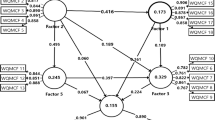Abstract
The Muslim population is growing rapidly throughout the world and a sizable population of 6–8 million Muslims is estimated in North America alone. This population deals with a vast array of issues, including marital adjustment. Nevertheless, the marriage and family literature lacks the research needed to facilitate therapeutic treatment with Muslim couples adequately. Marital adjustment assessments that are commonly utilized have been tested on predominantly Anglo-American or Caucasian couples. The present study is a preliminary investigation of the Locke–Wallace marital adjustment test’s (LWMAT) reliability when administered to married, Muslim-American people.
Similar content being viewed by others
References
Al-sawy, S. (1991). Introduction to the principles of Islamic jurisprudence. Al-Istiqamah, 3(1), 70–72.
Carolan, M., Bagherinia, G., Juhari, R., Himelright, J., & Mouton-Sanders, M. (2000). Contemporary Muslim families: Research and practice. Contemporary Family Therapy: An International Journal, 22(1), 67. doi:10.1023/A:1007770532624. Retrieved 9 December 2007 from Academic Search Complete database.
Chen, Z., Tanaka, N., Uji, M., Hiramura, H., & Shikai, N. (2007). The role of personalities in the marital adjustment of Japanese couples. Social Behavior and Personality, 35(4), 561–572. doi:10.2224/sbp.2007.35.4.561.
Fisiloglu, H., & Demir, A. (2000). Applicability of the dyadic adjustment scale for measurement of marital quality with Turkish couples. European Journal of Psychological Assessment, 16(3), 214–218. doi:10.1027//1015-5759.16.3.214. Retrieved 6 December 2007 from PsycARTICLES database.
Haynes, S., Follingstad, D., & Sullivan, J. (1979). Assessment of marital satisfaction and interaction. Journal of Consulting and Clinical Psychology, 47(4), 789–791. doi:10.1037/0022-006X.47.4.789. Retrieved 6 December 2007 from PsycARTICLES database.
Hoult, T. F. (1969). The dictionary of modern society. Totowa, NJ: Littlefield, Adams.
Hunt, R. A. (1978). The effect of item weighting on the Locke–Wallace marital adjustment scale. Journal of Marriage and the Family, 40, 249–256. doi:10.2307/350756.
Islam, H. (1998). Married life in Islam: The nature and intimacy of the husband-wife relationship. Retrieved 13 February 2009 from About.com: Islam Website: http://islam.about.com.
Krokoff, J. L. (1989). Predictive validation of a telephone version of the Locke–Wallace marital adjustment test. Journal of Marriage and the Family, 51(3), 767–775.
Lambert, M. N., & Dollahite, D. C. (2006). How religiosity helps couples prevent, resolve, and overcome marital conflict. Family Relations, 55, 439–449.
LeMasters, E. E. (1957). Modern courtship and marriage. New York: Macmillan.
Locke, H., & Wallace, K. (1959). Short marital-adjustment and prediction tests: Their reliability and validity. Marriage & Family Living, 21(3), 251. Retrieved 6 December 2007, from SocINDEX with Full Text database.
McLaughlin, M., Cormier, S. L., & Cormier, W. H. (1988). Relation between coping strategies and distress, stress, and marital adjustment of multiple-role women. Journal of Counseling Psychology, 35(2), 187–193.
Morris, J., & Lee, Y. (2004). Issues of language and culture in family therapy training. Contemporary Family Therapy: An International Journal, 26(3), 307–318. Retrieved 9 September 2007, from Academic Search Complete database.
Rehman, T., & Dziegielewski, S. (2003). Women who choose Islam. International Journal of Mental Health, 32(3), 31–49. Retrieved 6 December 2007, from Academic Search Complete database.
Smith, T. W. (2002). The polls-review: The Muslim population of the United States: The methodology of estimates. Public Opinion Quarterly, 66, 404–417.
Spanier, G. (1973). Whose marital adjustment? A research note. Sociological Inquiry, 43(1), 95–96. Retrieved 6 December 2007, from Academic Search Complete database.
Thomas, E. J., Yoshioka, M. R., & Ager, R. D. (1994). Life distress inventory. In J. Fischer & K. Corcoran (Eds.), Measures of clinical practice: A sourcebook (2nd ed., p. 267). New York: Free Press.
Ying, Y. (1991). Marital satisfaction among San Francisco Chinese-Americans. International Journal of Social Psychiatry, 37(3), 201–213. Retrieved 6 December 2007, from PsycINFO database.
Yoshioka, M., & Shibusawa, T. (2002). The life distress inventory: A psychometric evaluation. Research on Social Work Practice, 12(6), 752. Retrieved 6 December 2007, from Academic Search Complete database.
Author information
Authors and Affiliations
Corresponding author
Rights and permissions
About this article
Cite this article
Haque, A., Davenport, B. The Assessment of Marital Adjustment with Muslim Populations: A Reliability Study of the Locke–Wallace Marital Adjustment Test. Contemp Fam Ther 31, 160–168 (2009). https://doi.org/10.1007/s10591-009-9087-5
Received:
Accepted:
Published:
Issue Date:
DOI: https://doi.org/10.1007/s10591-009-9087-5




